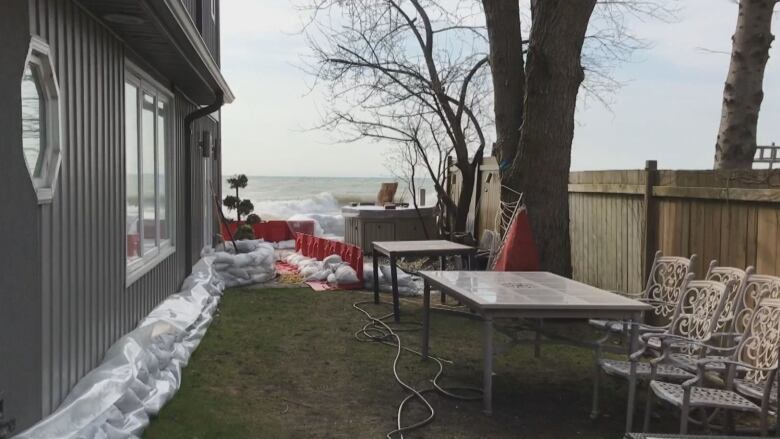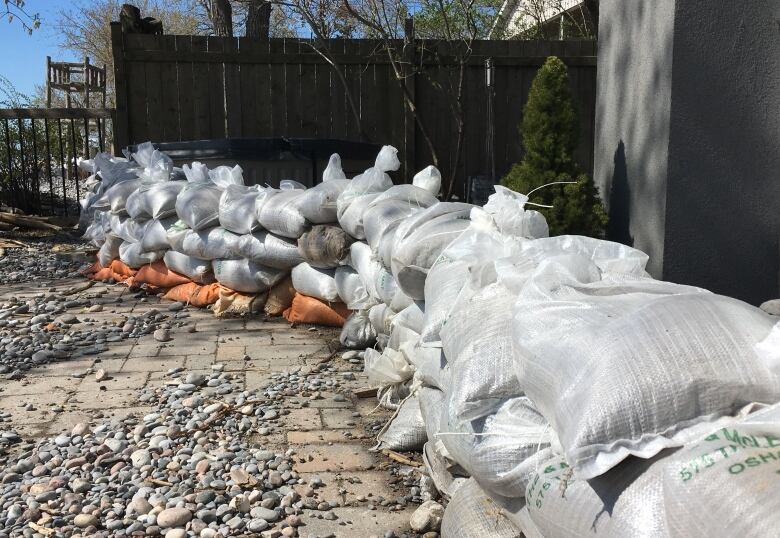Bowmanville braces for possible flooding with sandbag walls on shoreline
Residents place 15,000 to 20,000 sandbags around homes as lake levels to peak in early June

Residents have placed an estimated 15,000 to 20,000 sandbags along the shore in Bowmanville as the community east of Toronto braces for rising water from Lake Ontario.
Volunteers spent part of Wednesday filling sandbags while stafffrom the municipality of Clarington and Durham Region worked to bolster existing sandbag walls to protect properties in theCedar Crest Beach area.
Students from two public high schools, Clarington Central Secondary School and Bowmanville High School, have also helped to fill sandbags in what officials say has become a community effort.
Lake water levelsare expected to reach a peak of 75.8 metres in early June, according to the Central Lake Ontario Conservation Authority. The peak will likely be roughly 10 centimetresless thanthe levelsreached in 2017. The lake level is currently 75.7 metres. In 2017, the lake level reached a peak of 75.9 metres.
Community 'at the mercy of Mother Nature,' mayor says
Clarington Mayor Adrian Foster said the community is concernedbecause the worst is yet to come.
"We are certainly at the mercy of Mother Nature," Foster said. "The lake level is still incredibly high and we know that the levels haven't peaked yet. There's a lot of concern. People are tired. They have been sandbagging. People are certainly anticipating what's coming next."

Foster said the community is monitoring the weather forecast closely.
"We need to keep an eye on how much rain is coming down. And the big thing for those properties is the wind coming off the lake, pushing the lake right up against the houses."
Municipality much better prepared than in 2017
But Clarington Fire Chief Gordon Weir said the community is much better prepared today than it was in 2017. He said it has learned from the flooding that occurred when lake levels reached historic highs two years ago.
Weir said the area had never seen the kind of flooding it experienced in 2017 and was scrambling. Currently, the community is still at risk, he said.
"With rising lake levels, the residents along that beach area are seeing higher water levels that are starting to impact their properties. And when we get winds that are pushing towards the beach, it's driving the water from the lake up over the beachhead and flooding their properties and causing some flooding with their homes."

Weir said Clarington Emergency and Fire Services has been meeting regularly with residents since early April to discuss mitigation efforts. It has also been monitoring lake levels and forecasts. In mid-April, the municipality began fillingsandbags.
"We've basically been in that mode since," Weir said.
Residents being provided with tools
The sandbags have been delivered to the residents. Clarington municipal staff, along with residents and volunteers, have created sandbag walls in front of and around the properties to protect from the wave surge.
With every major rainstorm, the staff fix gaps in the walls. Some residents still have sandbags from flooding in 2017.
"It's been ongoing," Weirsaid.
"We're assisting residents. We realize it's their properties, but we are trying to provide them with some tools that will help them mitigate any damage that is caused by rising lake water."
If the waters were to rise as high or higher than they did two years ago, nearly 40 properties on the waterfront could be at risk of flooding, he said. As long as there are nomajor windstorms, Weirsaid residents should be protected.
Fire crews would most likely evacuate the area if the road into itbecomes flooded by more than 12 inches, he said.

Officials are also keeping a closeeye on the water levelsin the Westside Marsh, located behind the properties. Once those levelsreach the lake level or higher,theproperties could be flooded from behind, he said. The marsh would havenowhere to drain whenitslevels are as high asthe lake.
"I don't think we're there yet, but that's what we're continuing to monitor, as we did in 2017," Weirsaid.
"Each day, we assess. We watch the weather and see how much precipitation is coming. We'll continue to monitor as best we can."
Storm event with surge, waves could cause grief
Perry Sisson, director of engineering and field operations for the Central Lake Ontario Conservation Authority, said much is dependent on the weather.
"In the Central Lake Ontario watershed, we do have some communities that are low-lying. With the lake being calm, like it is today, even though it is very high, they are just out of the water so they are okay," he said.
"But as soon as we get a storm event that starts to createa bit of surge or that drives up waves, then they are going to start getting back into the flooding problems again. It's really the storm surge and waves on top of the level that cause usthe most grief."
Sisson said the conservation authority hopes the flood-watch situation will be over by the end of June.












_(720p).jpg)


 OFFICIAL HD MUSIC VIDEO.jpg)
.jpg)



























































































